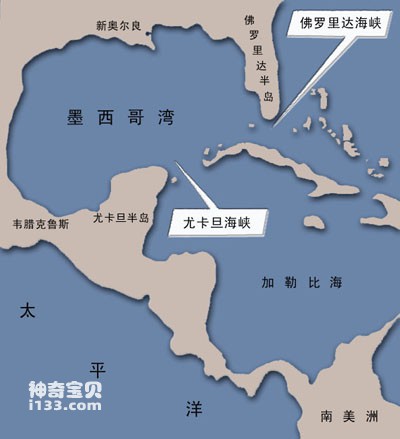On the southeastern edge of North America, there is an oblate gulf, named the Gulf of Mexico because it borders Mexico. The east and north of the Gulf are the United States, the west and south shores are Mexico, and the southeastern sea is Cuba. The Gulf of Mexico enters the Atlantic Ocean through the Florida Straits and is connected to the Caribbean Sea through the Yucatan Strait. It covers an area of about 1.5 million square kilometers. The average water depth is about 1,500 meters, and the deepest point is more than 5,000 meters.

Location map of the Gulf of Mexico
There are many twists and turns along the bay, and there are many swamps, shoals and mangroves on the shore. There are continental shelves, continental slopes and abyssal plains on the seabed. The famous Mississippi River flows into the north shore, bringing a large amount of sediment into the bay, forming a huge estuary delta. In the Yucatan Strait, there is a sill, about 1,600 meters below the sea surface, which serves as the boundary between the Gulf of Mexico and the Caribbean Sea.
The Gulf of Mexico is located in the tropics and subtropics, with high temperatures and rainy weather. The highest temperature is in August, which can reach over 28°C. The lowest temperature is in February, which is about 12°C in the north and 22°C in the south. There are often northerly winds in winter and typhoons in summer. There is a lot of precipitation, with an annual average of about 1,500 millimeters.

Ships anchored in Gulf of Mexico ports
The Gulf of Mexico gathers part of the North Equatorial Current and the South Equatorial Current, and also receives warm Atlantic water that is constantly driven in by the trade winds, making the water level in the bay much higher than the nearby sea surface, and turning the bay into a huge hot water reservoir. Warm water in the bay flows out of the Florida Straits and becomes an important source of the Mexican Warm Current. The Gulf Stream is the world's largest warm current, and the amount of hot water it carries is 120 times the total amount of all rivers in the world. It is estimated that the heat transported by the Gulf Stream to the coast of northwest Europe every year is equivalent to the heat released by burning 6 million tons of coal per kilometer, making the climate in northwest Europe warm and humid without severe cold in winter. The Gulf of Mexico on the west side of the Atlantic Ocean brought such great benefits to Europe on the east side of the Atlantic Ocean, but they themselves did not know it at first. Later, in the early 20th century, the mystery was solved by oceanographers.
The tide in the Gulf of Mexico is a diurnal tide that rises and falls every day; the tidal range is generally very small. Only during the typhoon season, the tide is driven by the typhoon, causing the sea water to rise sharply and become a storm surge. The water level is sometimes as high as 5 meters, which can cause serious damage to the coast. Depressions pose a threat, especially on the north shore of the bay where storm surges are high.
The Florida Peninsula on the Gulf of Mexico coast is more than 600 kilometers long from north to south and 200 kilometers wide from east to west. When the Spaniard Ponce de Leon discovered the peninsula, he saw the peninsula was blooming and colorful, so he named it "Florida", which means "flowers" in Spanish. This is the warmest place in the United States, and the coldest winter is only 15°C. It is a popular place to escape the cold and visit. The Mayan Mountains of the Yucatan Peninsula were once the birthplace of Indian culture. There are huge pyramids preserved here, which are comparable to those in Egypt.
animal tags:
We created this article in conjunction with AI technology, then made sure it was fact-checked and edited by a Animals Top editor.